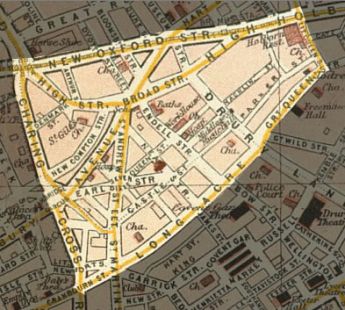VicLondon-St Giles
St. Giles, the City
|
District Traits
|
| Interactive: Access -4, Information -2, Prestige -5 Reactive: Safety -3, Awareness +1, Stability +1 |
Notable Locations
|
| Landmarks: Seven Dials, the Roof Roads |
Class: Lower to Criminal classes
The term “rookery” applies to neighbourhoods that are comprised of tight streets, substandard housing, and seriously poor residents. Crime is main pastime of a rookery, as these places are exceedingly dangerous for the police to enter in pursuit of their quarry. Charles Dickens dramatized, and romanticized rookeries in Oliver Twist, especially. If there is one rookery to end all others, it is St. Giles.
A triangular area crammed between Covent Gardens and Holborn, St. Giles has its boundaries at Charing Cross Road, Longacre and Great Queen, and New Oxford Street. It is a nest of small, winding streets and courts, often unlit at night. The housing is even worse. Most of the buildings are old, dangerously ill-maintained, and packed far beyond their capacity with the poor. Many tenants rent a space on a floor along with their families (or even strangers). Often the houses have bad ventilation and little or no lighting or furnishings. Small houses with a single room to them have entire families, ten to twelve at a pinch, living in tight quarters. Flats see people renting a spot on the floor in a small, dark room, with others packed in above them in naval-style hammocks. Some places rent spaces in pews or chairs, and tie the sleeper in, so that they do not fall over.
Crime
Drunkenness, violence, and debauchery are the result of such crushing poverty and hopelessness. Assault, robberies, prostitution, and murder are at epidemic levels, and at night rape and incest are commonplace. Illness is also rampant. Packed into airless dark rooms like slaves in a ship, disease quickly moves through the population of St. Giles. Many do not wash, or do so sparingly at standpipes in the street, or at the public baths at Broad and Endall Streets. There is a workhouse here, but it is more of a prison, really. It is located on Endell near the baths, and across a small road from the hospital.
Gangs run these streets and often they specialize in their crimes. Small groups, from pairs to six or ten men, are usually involved in petty crimes, operating in Covent Gardens or Holborn, or, if truly ambitious, ranging as far out as Bayswater. Pick pocketing or shoplifting, snatch and grab, and blackjacking are often their specialties. The larger groups operating in St. Giles are often protection rackets for prostitution, or for larger-scale crimes like burglary. Behind these groups, there are a few big gangs, 25-50 strong, that handle fencing, organization of defences against the police, or control of the most profitable of businesses in the rookery, booze.
Notable Locations
Seven Dials
Inside St. Giles is a location called Seven Dials. This is the worst St. Giles has to offer. It is a square where St. Andrew Street crosses Earl Street, with three other small streets converging, as well. A column with six sundials (the column is the seventh) stands in the middle and gives the court its name. Filth covers the streets in which the ragged and indigent children play. The shops sell only the most distressed hand-me-downs, and it is not uncommon to see people nearly naked.
The Roof Roads
Across the rooftops, there is another set of streets. Wooden planks crisscross the roofs, and are used by the criminal element to move about the district quickly, do surveillance on marks or police raids, and stage attacks with speed and surprise. Up here also are “the pigeon men,” bird aficionados who raise and keep pigeons, falcons, and songbirds in pens. Pigeon is a mainstay of the St. Giles’ diet.
